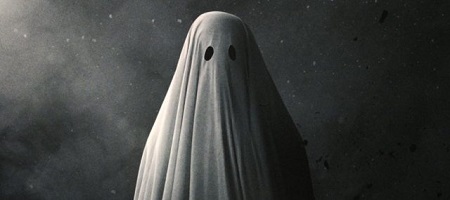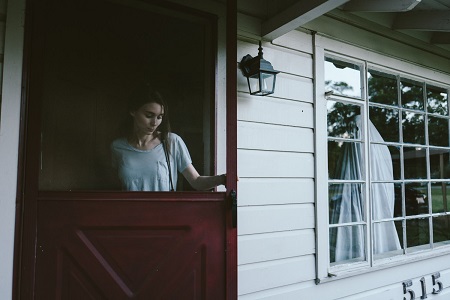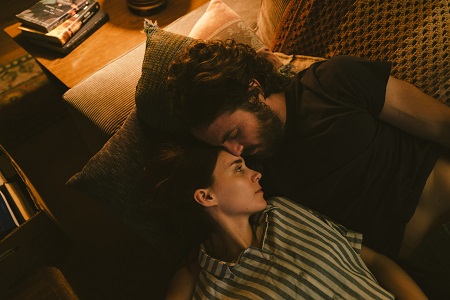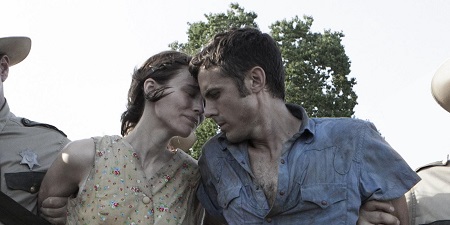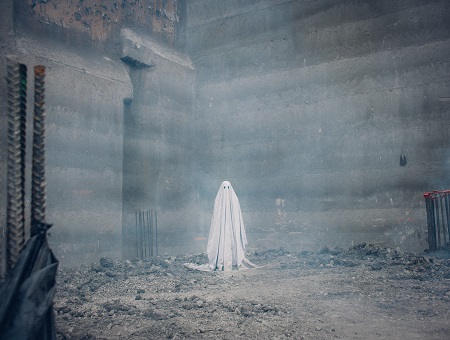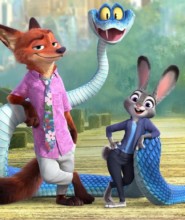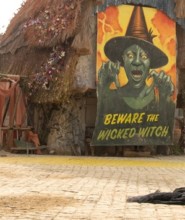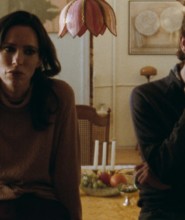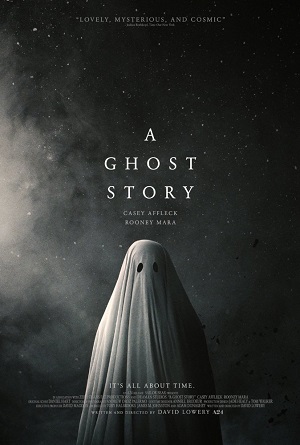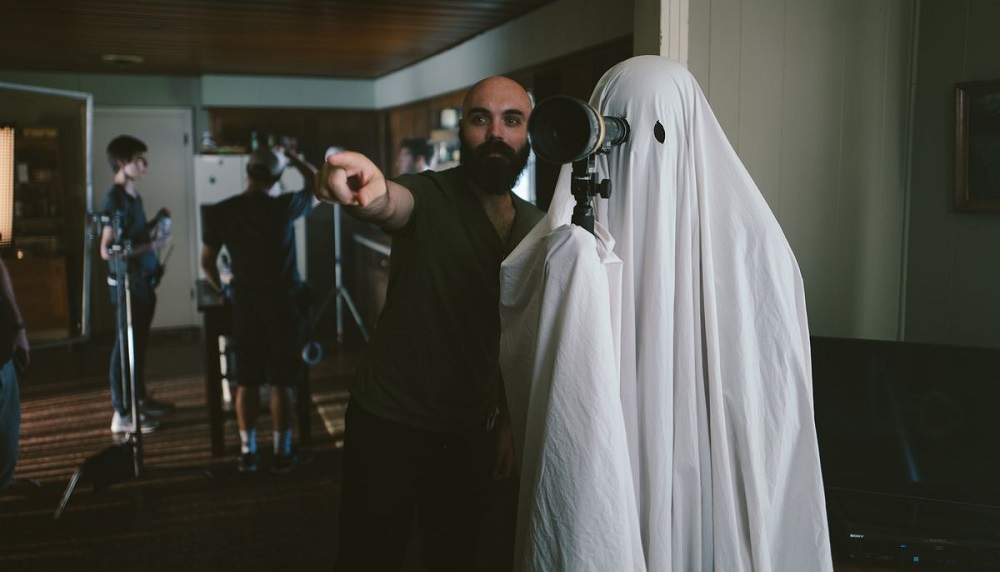
“A Ghost Story” – Interview with David Lowery
by Sara Michelle Fetters - July 19th, 2017 - Film Festivals Interviews
a SIFF 2017 review
A Beautiful Thing
David Lowery on Eating Pie, Existential Mysteries and Crafting A Ghost Story
David Lowery exploded onto the scene with his effortlessly ethereal throwback Ain’t Them Bodies Saints in 2013, a dreamy 1970s-set Texas thriller with Rooney Mara and Casey Affleck as young lovers reuniting years after a bank robbery gone bad. He followed that up with last year’s stunning, surprisingly passionate Pete’s Dragon remake for Disney, the talented writer/director delivering an enthralling, emotionally pure fantasy fit for audiences of all ages that played deft homage to the 1977 original yet still surpassed it as far as its storytelling confidence and emotional resonance were concerned.
Lowery returns with A Ghost Story, a moody, naturalistic and minimalist drama about a Texas couple who finds their marriage suddenly shattered when one of them dies in a tragic accident. But the dearly departed member of this pairing refuses to disappear, returning to their family home as a ghost shrouded, quite literally, in a white sheet, floating from room to room as it surveys the life of its mourning partner and, after they leave to parts unknown, the home itself as it changes hands over an undisclosed number of years. It reunites the filmmaker with Mara and Affleck, the former playing the distraught wife while the latter huddles under a sheet as the observational spirit of the husband whose human life was cut short at an early age.
A critical smash at this past January’s Sundance Film Festival, A Ghost Story also played this year’s Seattle International Film Festival (SIFF) in early June. Making his first trip back to SIFF since introducing Ain’t Them Bodies Saints here back in 2013, I had the chance to sit down with Lowery for a half hour or so to discuss the ins and outs of his latest minimalist triumph. Here are some of the highlights from that conversation:
Sara Michelle Fetters: What’s the rollercoaster ride been like? Post Ain’t Them Bodies Saints?
David Lowery: It has been a rollercoaster for sure. It’s got its ups and downs, and its lulls and sharp curves, and its turns and loops, but by and large it has been a great couple years. I feel like Has it been four years? I guess it was four years ago because [Ain’t Them Bodies Saints] came out in 2013. [laughs]
Sara Michelle Fetters: When were you struck with the inspiration for A Ghost Story? Was it while you were making Pete’s Dragon?
David Lowery: We were finishing Pete’s Dragon, and we were in the final stages of the edit and in moving into things like color correction, sound mixing and scoring. I don’t remember the exact date, just the general time. It came to me all at once, and when I say it came to me all at once, that means that a lot of ideas that had been circling around in my brain for a while had finally accumulated enough mass to generate, in this case, a 10-page outline. I just sat down and wrote it. The next day I kept working on it and turned it into a 30-page script. I sent that to my producing partners and said, “Hey, let’s make this in the summer.” It was a very spontaneous generation. It was probably late February, early March of last year that it [the script] happened, and we shot it in June.
Sara Michelle Fetters: Where do you think the inspiration came from for this? The film in many ways is a sort of Antonioni-esque or Bergman-esque meditation.
David Lowery: It came from a number of things, one of which is my continued obsession with physical space, particularly represented in old houses in Texas. I keep making movies about old houses in Texas. There were a couple other things, though, one of which was a fight that I’d had with my wife about where we were going to live, and that fight felt like a scene from a movie. I remember telling her in the moment, “This feels like a scene from a movie,” and ultimately it became one because I wrote it down and then we shot the whole thing. That was there. The idea that we were thinking of moving or we knew we had to move because we were making Pete’s Dragon and needed to be in LA, and she was excited about moving to LA, but I really didn’t want to leave Texas, and so we were just debating do we stay in one place? Do we have two places? What should we do?
It was one of those simple decisions that just got way too emotionally complex and it led to me laying awake the night before we drove to LA, just on the floorboards of our old house wondering why I was so attached to [it], a house which we didn’t even own. It was just a rental. But I really was attached to it. I’ve been attached to every home I’ve ever lived in. I really, when I find a home, I just lay my roots down instantly and get very ingrained in that space. I was just wondering why I do that and how that always happens, and those questions were one of the things that led to this movie along with my longstanding desire to make a horror film with a guy wearing a sheet.
Sara Michelle Fetters: I was going to get to this later, but as you brought it up, for such a stripped-down, minimalistic film, I think you do take a couple big risks as far as the audience is concerned. One being that you have your main character walking around in a sheet like they’re out of a Scooby-Doo cartoon.
David Lowery: [laughs] Yeah. Totally. That was a bit of a risk.
Sara Michelle Fetters: Another major item is that you have a five-minute scene where a woman eats pie, which I’m sure you’ve talked about to death at this point. Did you know that would become such a hot topic of conversation? Rooney Mara eating an entire pie? Were you excited about challenging an audience like that? With the pie? With the pacing? With the ghost? All of it.
David Lowery: Absolutely. I always am excited about challenging the audience. Even in something like Pete’s Dragon, there are things in that movie that were exciting to me because I knew they would provoke people in a certain way, so that’s always part of what I’m after as a filmmaker, and that desire takes different forms depending on what the movie is and what the needs of the movie are.
Oddly enough, the ghost aspect of it never felt like it was going to be crazy. I always had complete confidence in that until we were shooting it, and then I lost all confidence completely, which is a whole different story. In the conception of it, that was something I just felt would work. It just made sense to me, and I didn’t think it would throw anyone for a loop. I just knew that if we did it correctly and did it properly, it would function as I intended it to.
As to the pace of the movie, I like movies that have really long shots, have a lot going on in them and that let you meditate on them, often lasting long enough for your brain to wander off in a million different directions and make their way back eventually. Those types of mental digressions are great when the movie facilitates them, and I love films that do that. I was excited to take the opportunity to make a film like that because I knew that I wouldn’t be able to do that at Disney by any means. You can’t hold a shot for five minutes on a Disney movie.
Sara Michelle Fetters: Although you do hold them for longer than Disney normal in Pete’s Dragon.
David Lowery: True. Yeah. Definitely true. [laughs]
I knew with [A Ghost Story] it would challenge audiences. I know if you’re going to see this movie, you’re not going to necessarily be ready to sit still for that long or to just focus on a quiet moment for as long as we ask you to focus on it, but that’s okay. Obviously this is a quote unquote “art house” movie, so I think audiences who go see it will kind of be conditioned. They’ll know what to expect. They’ll know at the very least they’re in for something different, and if you can get through that scene with the pie, then I think you’re home free because that scene sort of is like the litmus test. The shots are getting longer and longer until you get to that point, and that’s the longest one. That scene is almost 10 minutes long and that one shot of Rooney eating the pie is five minutes long, so if you can get through those two shots in that scene, and that one in particular, then I think you’re home free. If you accept it, then you’re great. You’re going to love the rest of the movie.
If you reject it, you are free to leave or just sit there grumpily waiting for the movie to end. For me, that scene is my favorite thing I’ve ever made. It is one of the few things I’ve made where I just feel like we nailed it. Usually I’m like, yeah, we almost got there. We almost did it. We had a good idea. We almost pulled it off. In that case, we pulled it off. It does challenge you, but if you meet it on its own terms and kind of take the time to get caught up in it, there’s a whole lot going on there.
When you’re making a movie, you have to watch it over and over and over again, and I get so tired of watching my films. When they’re finally done, I never watch them again. But that’s the one scene that I just, every time I watch it I’m just hypnotized. I’m like, I wasn’t ready for it to be over yet.
Sara Michelle Fetters: I know you’ve answered this, and you’re probably tired of doing so, but everybody always wants to know, how many times did you make Rooney eat that pie?
David Lowery: Just once.
Sara Michelle Fetters: Just once?
David Lowery: Yeah.
Sara Michelle Fetters: Wow.
David Lowery: Yeah. “Wow,” pretty much covers it. [laughs]
The first shot we did two takes of. That’s the one where she takes the first bite. The then the second shot where she eats it, we just did it once, and we knew that even asking her to do one take was a lot. Asking her to do two was too much. It was just like, if you do this, if we get the camera in the right place and if [Rooney] knows what the emotional arc of that scene is, and she’s a great actress, she’ll do it, and we would only need to do it one time.
An interesting factoid is we shot the ghost separately because it’s really hot in that outfit and I didn’t want him to faint and screw up the take, or to just trip. For anything to happen, really, so we shot her side of the scene and then we brought in the ghost. Then we did a plate of the ghost and composited the two together.
Sara Michelle Fetters: Well, there’s a seamless visual effect I had absolutely no idea about.
David Lowery: There’s a lot of them in the movie. I think we did a fairly good job of concealing them. Until the end, of course.
Sara Michelle Fetters: What was the conversation like with Rooney and Casey? Did they understand what you were going for right away? How did you explain these characters to them to get them on board?
David Lowery: Well, I’m in a lucky enough position to where I was able to just send them a text message each and say, “Hey, I’m making a weird movie this summer. Do you want to come be in it?” Casey was just like, “Sure, I’ll be there.” I’m sure there was some other responsibility that he was eager to get out of, so he was like, yeah, count me in. [laughs]
I don’t know if he even read the script until he got to town the day before we started shooting. He knew that he was going to be wearing a sheet, but I don’t think he knew much more about it than that, and that’s just the way he rolls.
Rooney definitely read it [the script] and we had a couple of long conversations about how we were going to shoot it. I remember her asking me, “Is this going to be a short film? Do you think it’ll be feature length?” Because the script was only 30 pages. I was like, I know it is short, but here’s how long this pie scene’s going to last. It could be as short as two minutes, it could be as long as 10 minutes. Here’s how long the scene in the hospital is. When it says that you walk out of the morgue and then time passes, that’s going to be like eight solid minutes. That’s like two eighths of a page in a screenplay, but we’re going to spend a long time on that. We didn’t talk so much about the characters because there wasn’t much to talk about. There’s not much on the page. There wasn’t that much.
There was the big argument that was 10 pages long, and we shot that whole thing. Not all of it is in the movie. Very little of it’s in the movie, but I wanted to shoot it. Beyond that, there wasn’t much there for them to go off of.
But the reason I wanted them on the film partially was because we’re friends, and that makes everything easier, but also because they just have such great chemistry together and I knew it wouldn’t take much to establish a sense of them being deeply in love and caring for each other. Of having that connection that is strong enough so that when it is broken, you would really feel a profound sense of loss and in particular, that Rooney would be able to convey that. Because she really does care for Casey, and when she was doing the scenes after he was dead, there was that sense of something missing in her life. I knew that they would be able to sell that. I didn’t have to write it. I didn’t have to talk to them about it. I just knew that by virtue of having them in the movie that would all be there.
Sara Michelle Fetters: With that in mind, do you have something against Casey Affleck and Rooney Mara having a happy ending?
David Lowery: [laughs] You know, it’s funny. There’s like a bunch of different things because it related to my feelings towards them as a couple onscreen, because in Ain’t Them Body Saints in the script, [Rooney] and Ben Foster were far more romantically inclined. They had much more of a romance. When we were shooting, I just fell in love with her and Casey so much. I was like, she would never turn her back on this love that is now gone for someone else, and we changed it as we were shooting. It was a good choice because I didn’t expect them to have so much chemistry.
In this case, there was a scene where as [Rooney’s] moving on in her life, she brings another guy home that time has passed. That’s totally fine. That’s totally acceptable. But none of us wanted to see that happen.
It was supposed to be a much more physically intense scene between the two of them, and I was like, that’s just heartbreaking. Let’s just focus on the ghost. Let’s focus on Casey and not see what he’s seeing because I don’t think the audience was going to want to see that because they still feel too attached to these characters and their relationship.
I do think the next step is indeed to make a movie where they can at least be on screen together for more than 10 minutes and where maybe they have a happy ending. [laughs]
Sara Michelle Fetters: This is totally silly, but can I tell you how much I wanted that guy in the doorway to be Ben Foster?
David Lowery: Wouldn’t that have been amazing? That would have been spectacular.
I would have loved it. I love meta continuity from one movie to the next, and it would have been such a nice little thing. I don’t know. It would’ve meant something for the people who catch it, because he’s mostly off-focus. For the people who catch it, it would’ve been really interesting. But this [A Ghost Story] was such a spontaneous last minute thing that, the whole production, that it somehow never occurred to me do that. To ask Ben. I wish I had. Now that you mention it, I wish I had.
Sara Michelle Fetters: Talk to me about the party sequence and our gentleman…
David Lowery: The prognosticator!
Sara Michelle Fetters: Yes. Him. He basically puts the movie in perspective for people that aren’t paying attention. Were you ever worried that you were spelling things out too much? Were you worried you were being sort of psychobabble-ish?
David Lowery: I was worried about it being psychobabble. He is that guy at a party who kind of just holds court and monopolizes everybody’s time, who has a sense of self-importance that perhaps isn’t warranted. I think we’ve all been to parties and met guys like that. At the same time, what he is saying kind of adds up. There’s a lot of inconsistencies. There’s some logical fallacies. But it does represent my own feelings about how I justify what I do every day. It represents me fumbling for a reason to get up every day and the justifications I’ve gone through in my life to make sense of things and to give myself hope and optimism in a world that so often feels like it doesn’t have any whatsoever in a very physical sense. There’s truth there, which is good. There is a sense that it is paving the way for a change in the film. It kind of sets the stage for the ghost and where the movie as a story is going next.
Then on another level, it is a breather to the audience because you’ve, at that point for an hour nearly, you’ve been sitting there watching this very, not abstract, but a very elusive film that doesn’t have a lot to grab onto, at least not at first blush. You might not have a lot to grab onto and you’ve been sitting in silence for a long time, and so it gives you something to grab onto. It allows you to just kind of take a break, hear some noise, listen to some dialog, engage on a level that you’ve not been able to engage with the film on for quite some time, and then leave that sequence ready for everything else that happens in the movie next.
It functions on all those levels. There is the fear on my part, or there always was and still is [the fear], that people will take it too seriously and presume that I think this is the deepest thing and that I’m laying bare the truths of the universe. It’s not. This isn’t that scene. It’s someone fumbling for answers, and that fumbling is what’s important. The striving for truth and for meaning is more important than the truth and meaning that he is suggesting exists.
Sara Michelle Fetters: Ain’t Them Bodies Saints was a pretty sizable critical hit. Pete’s Dragon was a sizable critical hit and did very well at the box office. This movie was exceedingly well-received at Sundance and seems to be doing the same everywhere else it’s played so far. Do you feel that pressure now? It’s rare when a filmmaker goes out three-for-three like this, and with wildly divergent films.
David Lowery: Totally. They couldn’t be more different.
Sara Michelle Fetters: So, do you feel that pressure, then? Or does this critical and audience acclaim just give you validation that you’re doing the right thing?
David Lowery: It’s interesting. It does give me a little bit of pressure. I didn’t expect any one of these movies to do as well as they did, and they keep doing better. Saints was pretty good. Pete’s Dragon was exceptionally well-received, and I stopped reading reviews after Saints because I just realized that it isn’t good for my psychological well-being, but I still understand that Pete’s Dragon was incredibly well-reviewed.
Sara Michelle Fetters: Well, maybe I shouldn’t say this, but it made my 2016 top ten.
David Lowery: Oh, my. Thank you. I’m very proud of it, so I’m glad that it resonated with people.
A Ghost Story, had no idea what people would make of it. I was ready for anything. I was ready to be pilloried for this movie, and so the fact that it’s been so well-received has been incredibly gratifying. It does in some ways keep that pressure going because I always want, you know, I used to write film criticism. I want people to critically respond in a positive way or to at least engage with the movie. I want audiences to like it, too. Sometimes those things don’t go hand-in-hand, so it’s a weird balance you have to kind of strike.
With the film I just finished shooting that I’m editing right now, I’m worried sick about all of this. I’m like, this one might be the disaster. This one might not work, because I’m always trying new things and I’m always trying to push myself in a different direction. With this one I tried to do comedy. I might not have pulled it off. I don’t know. We just started editing, so we’ll find out, but I’m in that stage right now where I was in the same place I was in with A Ghost Story last year, that place where I was just like, I don’t know if this is going to work. This might be it. M career might be over. I feel like I’m always there and I’m always trying to make it as good as I can. But I’m also incredibly worried that, whether it’s critics or audiences or a combination of the both them, I’m worried that the next one’s going to be the one that jinxes everything and that proves to be the first failure.
But being scared is good. Being scared is great because that means you’re trying something. I’m content to remain being scared, having those worries, having those long nights where I just can’t sleep because I’m worried I screwed everything up if that means that I’m consistently pushing myself. I hope that if the critics and audiences stay on board, that’s going to be a beautiful thing and make me very happy. But it hopefully won’t get me too comfortable because I want to always be striving for something different with every film I make.
Sara Michelle Fetters: With that in mind, what do you hope audiences take away from this film?
David Lowery: I think, more than anything, a sense of comfort and peace. That’s what I wanted from it. For me, it’s a film about finding comfort in our place in the universe or with the passage of time specifically. I made the movie so intuitively and so quickly and organically that I never had a thesis statement prepared when I went into it. I still don’t. I still watch the movie when I see it as an audience member. I still am kind of amazed and befuddled by it, and yet it leaves me every time with a great feeling of solace and peace and comfort. It feels like it’s a movie that’s tucking you in at night in a very cozy fashion, and so that’s what I hope people get out of it because that’s what I get out of it. But I also know that so many audiences are getting different things out of it.
People are talking to me after screenings or Q&As and they all get different things from it, so the fact that I went into it with some degree of just operating on gut instinct and made something that surprised me in the manner in which it functions. The fact that that [A Ghost Story] can also encompass so many other different feelings and so many different reactions that are all 100% sincere and all 100% true, that’s a beautiful thing to me.
– Interview reprinted courtesy of the SGN in Seattle
